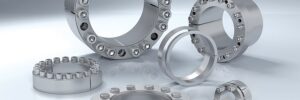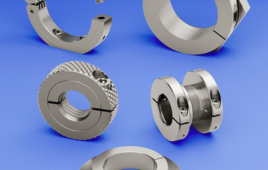 If you want a wear-free way to join shaft components, look no further than locking assemblies. These frictional devices take the place of keyed connections that wear and slip over time. Let’s take a closer look at how locking assemblies work — including their advantages over traditional keyways in high-torque applications.
If you want a wear-free way to join shaft components, look no further than locking assemblies. These frictional devices take the place of keyed connections that wear and slip over time. Let’s take a closer look at how locking assemblies work — including their advantages over traditional keyways in high-torque applications.
What is a frictional locking device? Locking devices join shaft components by making 360° contact with the shaft and its mating component. As you tighten the assembly, it expands radially—creating a robust compression fit between the two parts. Within the device, these compression forces are generated through the interaction of tapered surfaces on the locking assembly’s inner and outer thrust rings.
Locking devices differ from keyways, which rely on interference—rather than a frictional fit—between the two parts. The mechanical fit makes them ideal for high-torque applications like packaging machines, cranes and hoists.
Why would you use one? Locking assemblies are your best bet whenever you need to connect a shaft to a hub. Common applications include bulk material handling, robotics, drilling machinery, rotating equipment, warehouse automation, motors, compressors, pumps—and more.
How do you install one? Installation is quick and easy. To begin, tap the locking assembly to loosen its screws and then apply the jacking screws. Next, place the assembly on the shaft and tighten the locking screws in quarter-turn increments. To uninstall, simply remove the locking screws and use the jacking screws to release the connection.
What advantages do locking devices have over keyways? Traditional keyways feature sharp corners that increase the stress factor under load. In reciprocating applications, this design concentrates torque-transmission stresses along a single line of contact. Locking assemblies overcome this challenge. They uniformly distribute stresses over 360 degrees of contact—eliminating wear and reducing your maintenance costs.
Other advantages include:
Zero backlash. The 360-degree connection eliminates backlash—making locking assemblies ideal for precision-based applications like labeling and robotic positioning.
Easy installation. The process takes only a few minutes. Simply tap the disc to loosen the screws, apply the jacking screws and then tighten the locking screws in quarter-turn increments.
Flexibility. You can install a locking assembly in any orientation. It allows 360 degrees of freedom unlike keyways, which require perfect alignment between the shaft and hub.
I
nterchangeability. Locking assemblies come in a standard design — facilitating maintenance and repairs. If you need to replace one, simply swap out one component for another.
Lower costs. Unlike keyways, locking assemblies don’t require machining. They also require less maintenance—lowering your overall costs.
How to Eliminate Bending Moment Failure
In drum or pulley shafts, bending moments create high stresses within locking devices that can shear the connection and result in premature failure. Fortunately, some locking devices are specially designed to tolerate bending moments:
Look for materials that have higher yield strengths.
Wider designs resist bending moment forces better and are less likely to lift away from the shaft.
Optimizing the number and location of bolt holes in the locking assembly improves the device’s resistance to moment loads by lowering stresses within the locking assembly to acceptable levels.
Taking the benefits of locking assemblies even further, our online calculator quantifies bending moments automatically — providing your application with a reliable, properly sized device. As an added bonus, this service prevents you from using oversized components, which can drive up your costs.
Ringfeder
www.ringfeder.com
Filed Under: Warehouse automation, Collars • locking devices, Coupling Tips





Tell Us What You Think!